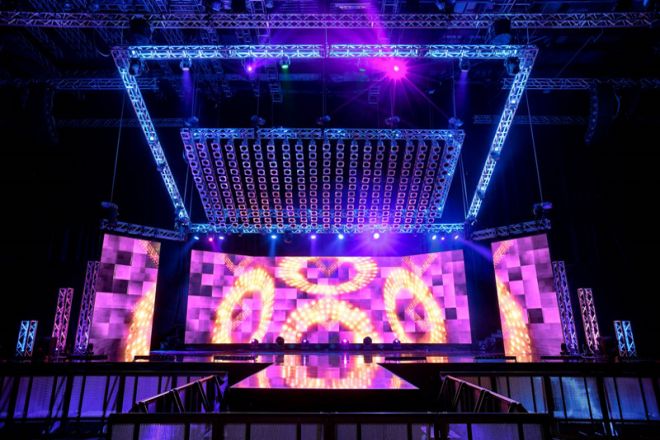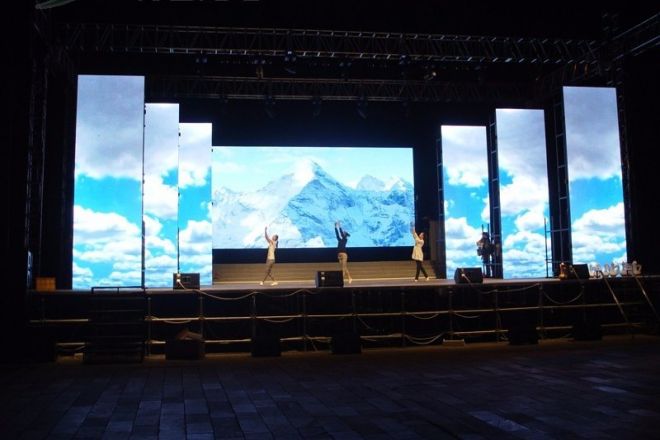序章

の stage LED screen is an indispensable and important element in modern stage art, and its selection and application play a vital role in the stage effect.
In colorful stage performances, stage screens can not only bring visual shock to the audience but also deepen the theme, create atmosphere, and enhance artistic appeal. Therefore, how to choose a suitable stage screen to complement the stage performance has become an important issue that stage designers and production personnel must face.
Choosing a stage screen is a complex and detailed task that requires you to consider multiple factors. This article will deeply explore the unique factors for choosing a stage screen from many aspects, such as material, size, technical performance, adaptability, etc.
1. Material selection for stage LED screen
In stage art, LED display screens have become an indispensable visual element of the modern stage with their unique advantages, such as high definition, high brightness, and bright colors. However, different materials have a significant impact on the visual effects and safety performance of stage LED screens. Therefore, choosing the right material is the key to ensuring that the stage LED screen can fully play its role.
First, let’s take a look at the impact of materials on the visual effects of stage LED screens. High definition is one of the basic requirements for stage LED screens. It can ensure that the audience can clearly see the content on the screen no matter where they sit.
The degree of color reproduction is related to whether the stage LED screen can truly and accurately present the colors on the stage, which is crucial for creating a stage atmosphere and enhancing the audience experience. In addition, reflectivity and viewing angle are important factors that affect visual effects.
Materials with excessive reflectivity may cause the screen to reflect under strong light, affecting the viewing effect, and the viewing angle determines whether viewers can obtain a good viewing experience at different locations.
Therefore, when choosing the material for the stage LED screen, we need to comprehensively consider these factors to ensure that the screen can present the best visual effect in various environments.
In addition to visual effects, materials also have a non-negligible impact on the safety performance of stage LED screens.
Fire resistance is one of the factors that must be considered in the material selection of stage LED screens. Since various fire sources may be involved in stage performances, the material of the LED screen must have good fire resistance to ensure that the fire source can be quickly extinguished and prevent the spread of fire in unexpected situations.
In addition, impact resistance is an important indicator of the safety of stage LED screens. During transportation, installation, and use, LED screens may be impacted by various external forces, so their materials need to have sufficient impact resistance to prevent the screen from cracking or damage.
2. Size and layout of stage LED screen

When building a stage, the size and layout of the LED screen are two core elements. They are not only closely connected with the spatial layout of the stage but also directly related to the perfect presentation of the stage effect and the final experience of the audience.
First, we deeply discuss the adaptability of LED screen size and stage space. The size of the stage often becomes a key factor in determining the size of the LED screen. An LED screen that is too small may make the stage appear empty and cannot make full use of the stage space, while an LED screen that is too large may make the stage appear crowded and affect the overall aesthetics.
Therefore, in order to ensure harmony between the stage and the LED screen, we need to conduct precise measurements and calculations on the stage. This is not just a simple comparison of length, width, and height but also factors such as stage layout, lighting, props, etc., that need to be taken into consideration to ensure that the size of the LED screen and the stage space achieve the best matching effect.
At the same time, the distance between the audience and the audience is also a factor that cannot be ignored when determining the size of the LED screen. The viewing distance and viewing angle of the audience directly affect their reception of screen content.
If the audience is far away, a larger LED screen is needed to ensure that the screen content is clearly visible; if the audience is closer, the screen size can be appropriately reduced to avoid visual oppression for the audience. Therefore, when determining the size of the LED screen, we must fully consider the viewing needs of the audience to ensure that the screen content can be accurately conveyed to every audience.
In addition to adapting the size of the stage space, the layout of the stage LED screen is also crucial. The combination of a single screen and multiple screens will bring completely different visual effects. The single-screen layout is simple and direct, able to clearly display the main content, and is suitable for some simple and direct stage background or subtitle display.
The multi-screen combination is more flexible and can bring a richer visual feast to the audience through switching, splicing, and interaction between different screens. This layout method not only increases the layering and three-dimensionality of the stage but also allows the audience to maintain a high degree of interest and attention during the viewing process.
In addition, the position and angle of the stage LED screen are also important factors affecting the audience experience. A reasonable location layout can ensure that viewers can see the screen content from all angles and avoid visual blind spots.
This requires careful consideration based on the shape and size of the stage and the distribution of the audience to ensure that the LED screen can cover the audience’s sight to the greatest extent. Appropriate angle adjustments can make the screen content more suitable for the stage performance, making the audience more immersed in the performance.
By adjusting the tilt angle, rotation angle, and other parameters of the LED screen, we can make the screen content closer to the audience’s sight and improve the audience’s viewing experience.
3. The technical performance of the stage LED screen
The technical performance of the stage LED screen is the core standard for evaluating its quality and effect. It covers multiple key indicators, each of which directly affects the display effect and user experience of the screen. Below is an in-depth analysis and discussion of the performance of these technologies.
The first is resolution and pixel density. Resolution is the smallest detail unit that the stage LED screen can display. It determines the number of pixels that the screen can display. High resolution means more pixels on the screen, which can present more detailed and rich image content.
In stage performances, high-resolution LED screens can accurately display the subtle expressions of characters, the textures of costumes, and the details of background images, making the audience feel as if they are part of the performance. Pixel density is the number of pixels per unit area, which reflects the fineness of the screen.
The high pixel density makes the images on the screen clearer, and every detail can be accurately presented, improving the overall look and feel of the picture.
The second is the refresh rate and response time. The refresh rate refers to the number of times the screen can be refreshed in one second, which determines the smoothness of dynamic images. Stage performances are often accompanied by rapid movements and scene-switching.
If the refresh rate is insufficient, it will cause smearing or blurring on the screen, affecting the audience’s viewing experience.
High refresh rate LED screens can reduce this phenomenon and make dynamic scenes more natural and smooth. At the same time, response time is also an important indicator for evaluating screen performance. It refers to the time it takes for the screen to receive the signal and actually display it.
The low response time LED screen can quickly respond to input signals, reduce picture delays, and ensure that the audience can see every wonderful moment on the stage in real-time.
In addition, brightness and contrast are also important components of the technical performance of stage LED screens. Brightness determines how the screen performs under different lighting conditions. In a bright stage environment, the high-brightness LED screen can remain clearly visible, ensuring that the audience can easily view the screen content.
In a darker environment, moderate brightness can prevent the screen from being too dazzling and protect the audience’s vision. Contrast affects the layering and three-dimensionality of the picture. A high-contrast screen can present a more vivid and three-dimensional image, making the picture clear in black and white and full of color, enhancing the audience’s visual experience.
5. The adaptability and flexibility of stage LED screens

The adaptability and flexibility of stage LED screens are the key to their wide application in different occasions and environments. Whether indoors or outdoors, stage LED screens need to be able to adapt to various complex and changing environmental conditions.
初めに、 the stage LED screen needs to adapt to the differences between indoor and outdoor environments. The indoor environment usually has relatively stable light and relatively suitable temperature, while the outdoor environment may face adverse factors such as strong sunlight, high temperature, low temperature, and rain.
Therefore, a high-quality stage LED screen must be waterproof, dustproof, sunproof, and resistant to high and low temperatures to ensure that it can work normally in various harsh environments.
第二に, environmental factors such as light and temperature will also affect the display effect and service life of the stage LED screen. Excessive light may cause screen reflection or color distortion, while excessive temperature may affect the life and stability of the LED light.
Therefore, the stage LED screen needs to have the function of automatically adjusting brightness and color temperature to adapt to viewing needs under different lighting conditions. It also needs to adopt an efficient heat dissipation design to ensure that the screen can maintain a stable temperature during long-term use.
In addition to adaptability, the flexibility of stage LED screens is also an important factor in their wide application. The foldable and applicable design allows the stage LED screen to be flexibly combined according to different stage sizes and shapes to meet various complex construction needs.
At the same time, the adjustable angle and height functions allow the screen to be flexibly adjusted according to different performance needs, ensuring that the audience can get the best viewing experience.
結論
To sum up, choosing a stage screen is a complex task that requires comprehensive consideration of multiple factors. The most appropriate choice can only be made based on a full understanding of stage needs, audience preferences, and safety requirements.
最後に、LEDディスプレイについてさらに詳しく知りたい場合は、 ご連絡ください。
